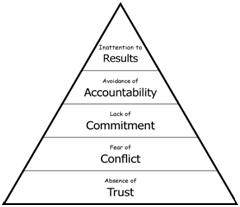Lencioni’s pyramid of team dysfunctions
Contents |
Abstract
Discussing the importance of human resource management in projects, how it will change during the lifetime of the project, and controversies regarding the subject.
Introduction
Definition
What is it and why is it important
Stages of human resource management (HRM) - Big idea
Planning HRM
In this stage the human resource management is focused on identifying the necessary roles, responsibilities and skills for the project and to create a staffing managing plan. This is done based on the constraints present for the project, the estimated time line and environmental factors such as organisational structure and pre-existing human resources etc. To document the team member roles and responsibilities a project manager can utilise several types of organisational charts or matrixes to ensure that every work package has a person that is responsible for it and that all team members are aware of what their role is. The traditional way of doing this is by a hierarchical chart, which can be used to illustrate the organisational breakdown structure (OBS), the work breakdown structure (WBS) or the resource breakdown structure (RBS). Other tools that are commonly used are the responsibility assignment matrix (RAM) or text based formats, like role descriptions.
The different types of charts and descriptions can be beneficial for the different aspects of human resources planning; for example can a hierarchal chart is good for the more general descriptions, but can become very complex when trying to illustrate the more specific role descriptions. Another important aspect of this stage of human resource management is to gain understanding of how the organisation works and how teams and people work both individually and together. This phase should result in the project’s human resources management plan, which involves the necessary roles and responsibilities, organisational chart and a staffing management plan.
Acquiring team
This phase is, as the name implies, concerned with the acquisition of the people that make up the project team. Following the human resources management plan, this phase will ensure that there are people ready to take on their given responsibility at the given time. Depending on how the project is organised, the formation of the team can be done in different ways. Pre assigning people is done if the project is dependent on a specific person to do a job or if he or she is part of the contract. Negotiation is often a natural part of team formation, where the project management will negotiate with the potential staff’s manager, other teams or external contacts to ensure that they agree on the terms of the formation. Acquisition, or hiring, will take place if the competency or shear volume of people is not available within the mother organisation. If the physical presence of team members is not essential for the project, virtual teams can be a good solution to save money and gain the necessary competencies without massive travel expenses. When acquiring the team it is important to ensure that the right people are brought on board. This can be done by using the multi-criteria decision analysis, which rates personnel by scoring them on availability, cost, experience, ability, knowledge, skills, attitude, and international factors.
Developing team
Developing the team is, according to the PMBOK guide, the process of “improving competencies, team member interaction, and overall team environment to enhance project performance”. This is perhaps the most important task for a project manager and revolves around making the team the best it can be. This can be done by improving both the individual’s and the team’s skills in addition to focusing on the way the team works together.
Tuckman’s ladder
In 1965 Dr. Bruce Tuckman published an article called Developmental Sequence in Small Groups [1] in which he presented the Forming Storming Norming Performing model. This model describes the stages of development most teams go through in order to reach optimal performance. It was later revised to add a 5th stage, adjourning.
Forming: The team members get to know each other and the project and agree on responsibilities.
Storming: The work is starting, and in this phase the group is susceptible to conflict if the members are not open to differing ideas.
Norming: In this phase the members get closer, start working better together and gain a common understanding of the work to be done.
Performing: Groups that reach this stage work effectively together, they are able to work independently and work through issues smoothly.
Adjourning: This added phase is appropriate for project groups as projects are temporary and the adjourning phase describes the completion of work and breaking up of the team.
Managing team
Main challenges in team management + APPLICATIONS
Lencioni's five team dysfunctions

Importance during the different stages of the project
Limitations
===Importance of the personnel factor === In the traditional view that has been presented thus far in this article, the human aspect, or the so called ”personnel factor”, is viewed as critical in regards to the success of a project. Some researchers, however, question this view and claim that the personnel factor has a limited impact on the project success. According to an empirical study performed by Pinto and Prescott the only factor that was marginal for the project success was indeed the personnel factor. This was also backed up by a study by Belout and Gauvreau , concluding that although there is some correlation between the personnel factor and the success of a project, this effect was so limited that it did not seem to have a significant impact. This can indicate that human resource management may not be as critical to project success as previously believed. Both studies do, however, note that the limitations of the correlation studies they have performed can